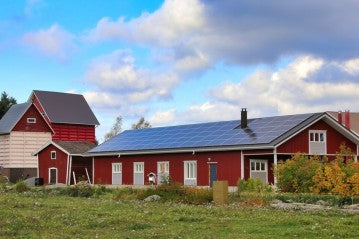
With the rising popularity of renewable energy, more individuals and businesses are seeking reliable and sustainable solutions to power their homes and facilities. One such solution that has gained significant traction is the grid-tied solar system. In this blog post, we will explore the numerous advantages of grid tied solar systems, shedding light on why they are a professional and viable choice for customers interested in harnessing the power of the sun.
Lower Energy Bills
Imagine significantly reducing your monthly energy bills while embracing a greener lifestyle. Grid-tied solar systems offer just that. By utilizing the abundant sunlight, these systems generate electricity that can power your home or business. The surplus energy produced during peak sunlight hours is fed back into the grid, resulting in energy credits that offset your overall electricity costs. This symbiotic relationship with the grid ensures substantial savings and a more sustainable energy consumption pattern.
Net Metering and Feed-in Tariffs
Grid-tied solar systems offer a unique advantage known as net metering. With net metering, any excess electricity produced by your solar panels is sent back to the grid, allowing you to receive credits for the energy you contribute. During periods of low sunlight or increased energy consumption, you can draw electricity from the grid, using the credits accumulated earlier. This balance ensures uninterrupted power supply and eliminates the need for expensive battery storage systems.
Furthermore, some regions offer feed-in tariffs, providing financial incentives for the excess electricity you generate. These tariffs allow you to sell your surplus energy back to the grid at a favorable rate, generating additional income while making a positive environmental impact.
Reliability and Grid Stability
One concern often raised about solar energy is its reliability during cloudy days or at night. Grid-tied solar systems address this concern with a built-in feature that connects them to the grid. During periods of low sunlight, such as cloudy days or evenings, your system automatically draws electricity from the grid to ensure a consistent power supply. This seamless integration guarantees reliability, making grid-tied solar systems a dependable energy solution.
Environmental Benefits
Grid-tied solar systems offer significant environmental advantages. By harnessing the sun's energy, these systems produce electricity without emitting harmful greenhouse gases or pollutants. Compared to traditional energy sources, grid-tied solar systems play a vital role in reducing carbon emissions, thus combating climate change. By investing in solar energy, customers contribute to a cleaner and more sustainable future for generations to come.
Increased Property Value
Apart from the environmental benefits, installing a grid-tied solar system can also increase the value of your property. Studies have shown that properties equipped with solar energy systems have higher market appeal and can command higher selling prices. Potential buyers are increasingly interested in properties that offer reduced energy costs and environmental sustainability. By investing in a grid-tied solar system, you not only enjoy the immediate benefits but also make a wise long-term investment.
Supportive Government Incentives
Governments around the world recognize the importance of renewable energy and offer various incentives to support the adoption of grid-tied solar systems. These incentives include tax credits, grants, and rebates that can significantly reduce the upfront cost of installing a solar system. By staying informed about these initiatives, customers can maximize their financial benefits while contributing to a greener planet.
Conclusion
Grid-tied solar systems provide customers with a reliable, cost-effective, and environmentally friendly way to power their homes and businesses. From lower energy bills and financial incentives to increased property value and reduced carbon emissions, the advantages of grid-tied solar systems are undeniable. By harnessing the power of the sun, customers can take charge of their energy consumption while making a positive impact on the planet. Embrace the future of sustainable energy and consider investing in a grid-tied solar system today!
Remember, your journey towards a greener and more sustainable future begins with the power of the sun and a grid-tied solar system.
Related articles: Going Off-Grid: Determining the Right Size Solar System for Your Needs

0 Kommentare